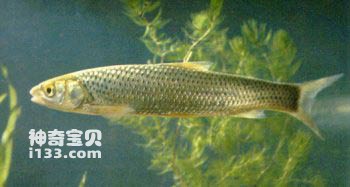Squaliobarbus curriculus belongs to the order Cypriniformes, family Cyprinidae, subfamily Squalio, and genus Squaliobarbus curriculus. Commonly known as: red-eyed rod, weed carp, drunken horneye, red-eyed trout, red-eyed dace.
The body is long, slightly cylindrical, with a round belly and a slightly flat back end. The head is conical, the snout is blunt, and the mouth is curved. It looks similar to grass carp, but it has red spots on the upper part of its eyes, hence its name. There are 2 pairs of very short whiskers on both sides of the upper jaw. There are 3 rows of hypopharyngeal teeth, the top of which is slightly hook-shaped. The eyes are large, close to the tip of the snout. The back of the body is dark gray, the abdomen is light yellow, and there are black spots on the rear edge of each scale on the sides and back, forming longitudinal stripes on the side of the body. The dorsal fin is dark gray, the trailing edge of the caudal fin is black, and the other fins are gray.

Red-eyed trout is a mid-level fish that likes to live in waters and lakes with slow river speeds. When the river water rises, they enter the small river and are active in clusters during the reproductive period. Juvenile fish often forage in shallow waters along rivers and lakes. Their food habits are mixed, mainly algae and higher aquatic plants. They also eat aquatic insects, small fish and eggs, as well as freshwater shell vegetables. The growth rate is slow and the individual is not large. The weight is less than half a kilogram at the age of 3 winter, and the largest individual is only 2-2.5 kilograms. They reach sexual maturity at age 2, and the reproductive season is from May to August. They usually lay eggs in areas with aquatic plants along the tributaries, and occasionally on shallow beaches.
Except for the Qinghai-Tibet Plateau, it is produced in all rivers and lakes in my country. Found abroad in North Korea and Vietnam.
Widely distributed in natural water bodies, it is a common edible fish with meat texture similar to grass carp. Each 100 grams of edible portion contains 16.1-17.1 grams of protein, 1.3-1.6 grams of fat, 2.4-3.4 grams of carbohydrates, 90-92 kcal of calories, 64-89 mg of calcium, 183-223 mg of phosphorus, and 0.6-0.9 mg of iron. . Its meat is used freshly as medicine. It has the effect of warming and neutralizing the stomach. It is mainly used to treat nausea and vomiting, spleen and stomach deficiency and cold, and diarrhea.
animal tags:
We created this article in conjunction with AI technology, then made sure it was fact-checked and edited by a Animals Top editor.